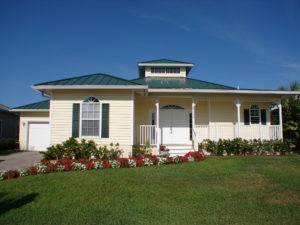 According to the Global Metal Roofing Sales Market Report 2018, the global metal roofing market was valued at nearly 15 billion dollars (US), with North America capturing more than 40% of the market share in 2017 – particularly with growing construction projects such as buildings and hospitals. However, while metal roofing is very popular in the commercial space, many homeowners are turning to metal roofing as well. McGraw- Hill Construction and Analytics estimated that 750,000 U.S. homeowners chose metal for their residences in 2015. This is 11 percent of the roofing market. This is second only to asphalt shingles. Interested in why homeowners are choosing metal? Are you considering metal for your own roof? We have the answers to your most common metal roofing questions.
According to the Global Metal Roofing Sales Market Report 2018, the global metal roofing market was valued at nearly 15 billion dollars (US), with North America capturing more than 40% of the market share in 2017 – particularly with growing construction projects such as buildings and hospitals. However, while metal roofing is very popular in the commercial space, many homeowners are turning to metal roofing as well. McGraw- Hill Construction and Analytics estimated that 750,000 U.S. homeowners chose metal for their residences in 2015. This is 11 percent of the roofing market. This is second only to asphalt shingles. Interested in why homeowners are choosing metal? Are you considering metal for your own roof? We have the answers to your most common metal roofing questions.
Anatomy of a metal roof
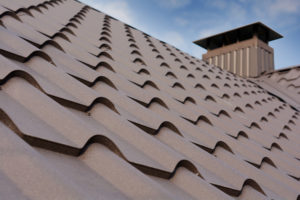 Metal roofs are available in multiple different metal substrates. Typical metal roofs can consist of:
Metal roofs are available in multiple different metal substrates. Typical metal roofs can consist of:
- Aluminum
- Aluminum-Zinc / Alloy Coated Steel
- Copper
- Hot-Dipped Galvanized Steel
- Zinc
Products used by metal roofing contractors are evaluated by their coating details, their gauge, and predetermined quality specifications. Such standards are the result of thorough testing, building codes and third-party research.
Metal roofing is typically stamped into a variety of shapes- often to mimic the look and feel of different roof types. In fact, you can often choose from mental shingles, metal shake, metal tile, metal slate, vertical panels, stone-coated, or even a custom-designed option. The Metal Roofing Alliance website offers a visualizer to determine the best type of metal and metal styling for your home.
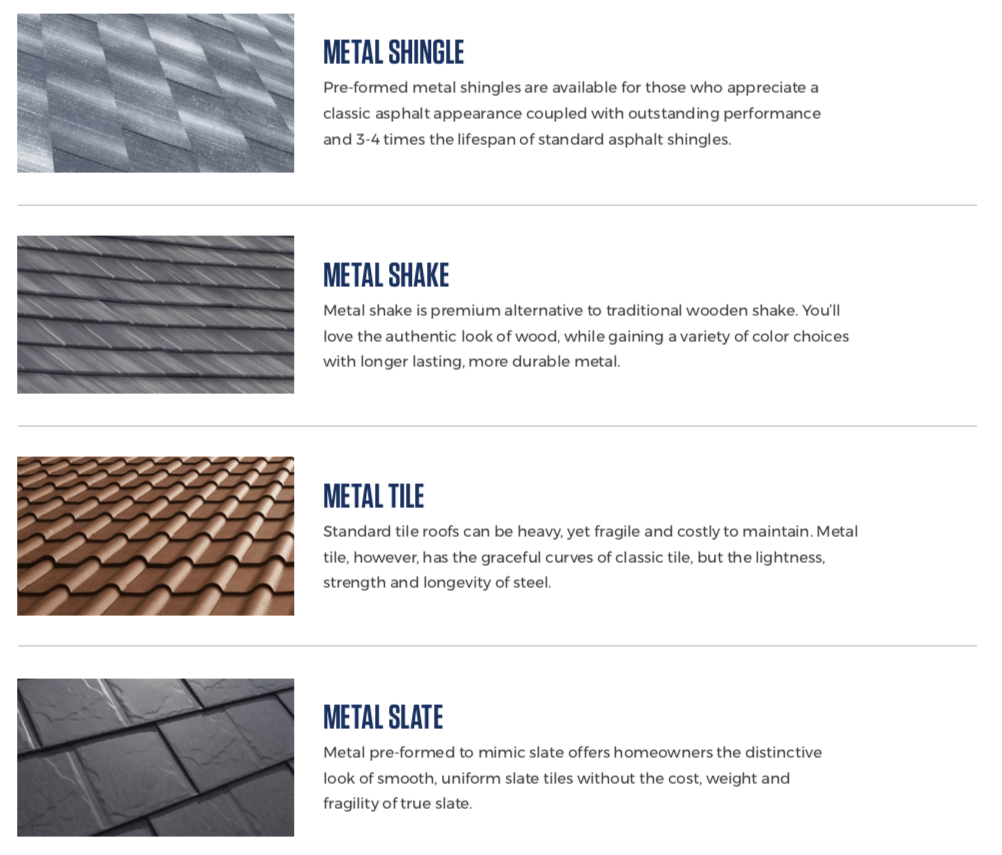
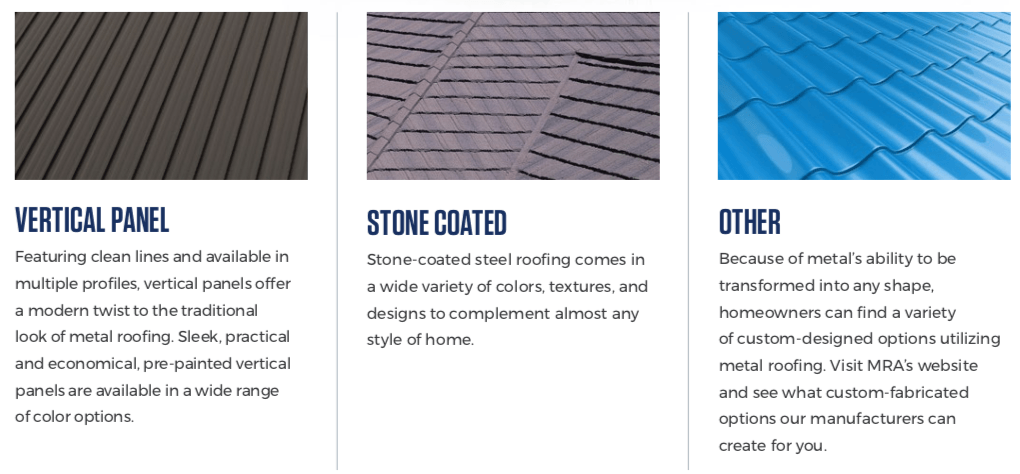
Beyond the structure of the metal, you can also choose from a long list of color options. With metal roofing, the choices are virtually limitless since you can choose from a multitude of colors or have a custom-designed look created. Because of its aesthetic versatility, metal can fit a wide range of home styles – bungalows, cabins, contemporary, and cottage-style homes, for example. However, it is important to consider your climate and environment when choosing a metal and aesthetic for your home.
What should you expect with a metal roof?
Climate & Environment
Moss and fungus proof: In comparison to asphalt, metal roofing is not affected by mildew, fungus and moss – shingle killers that are common in wetter climates. However, while they are resistant to mildew and fungus in wetter climates, metal roofing in coastal or marine environments should utilize non-ferrous metals such as aluminum and copper.
Severe winds from hurricanes and tornadoes: If your area is susceptible to hurricanes or tornadoes, it may be wise to consider a metal roof. Many metal products have been tested, and performed well, against wind speeds of 140mph (F2 tornado/ Category 4 hurricane). While the wind speeds a metal roof can withstand may vary, metal roofs also provide safety against falling debris.
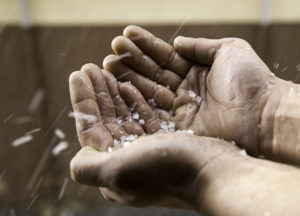
Hail: One of the most common metal roofing questions is about hail and how hail affects a metal roof. Structurally, a metal roof can withstand damage that would be catastrophic to the life of an asphalt shingle. However, depending on the size of the hail, it can have cosmetic damage and have dents after the storm.
Fire: Metal roofing, when installed with the proper system components, can meet the Class A fire rating. In other words, when you hire a licensed contractor familiar with your wildfire-prone community, your metal roofing system should be fire resistant.
Snow and ice: While metal roofs are popular in warmer clients for their ability to cool your home, they can also be beneficial in communities where snow and ice are common. Several styles of metal roofing encourage snow shed and can minimize the trend of ice damning thanks to their smooth surface.
Oil Canning
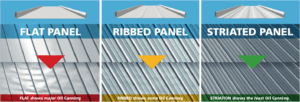
This is a naturally occurring phenomenon that will affect your metal roof. What is oil canning? Oil canning is when the look of your metal roof begins to change. While your roof’s design can determine the level of oil canning, it will happen nonetheless. Your roof will develop a “waviness” or dimple-like impressions on the metal’s surface. Flat panels will show major oil canning, while ribbed panels shows some, and striated panels will show the least.
Sustainable Material + Long Life = Friend of the Environment
Traditional asphalt singles increase dependency on fossil fuels thanks to their petroleum makeup. As we’ve discussed, they have to be replaced every 15 to 20 years. This, according to the EPA nearly 20 billion pounds of asphalt shingles end up in landfills each year!
Conversely, metal roofing is one of the longest lasting roofing materials on the market. Metal is also one of the most environmentally friendly roofing products available. Metal is typically made of at least 30% recycled materials (some are even 100% recycled!). All metal roofs are 100% recyclable when they do finally reach the end of their life span. That translates into far less waste in landfills- especially compared to other roofing products- and more reuse.
The dollars and cents of metal roofing
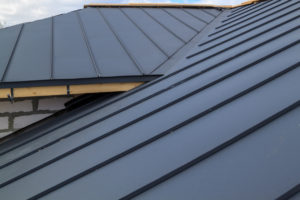 Metal roofing has a reputation of being quite expensive. Cost for a metal roof typically starts around $100 to $300 a square, with some styles running between $600 to $900 a square. This is in comparison to asphalt or wood shingles that average $265 to $375 a square. Higher end metals can actually run 10 times higher than that of asphalt shingles. However, in comparison to a material with a similar life span, clay tile can have an average price of $700 to $1,000 per square.
Metal roofing has a reputation of being quite expensive. Cost for a metal roof typically starts around $100 to $300 a square, with some styles running between $600 to $900 a square. This is in comparison to asphalt or wood shingles that average $265 to $375 a square. Higher end metals can actually run 10 times higher than that of asphalt shingles. However, in comparison to a material with a similar life span, clay tile can have an average price of $700 to $1,000 per square.
While the upfront cost can seem extreme, similar to tile, metal roofing has a much longer life span than asphalt shingles. As we mentioned previously, metal roofs are typically expected to last 40 to 75 years with a manufacturer warranty that can range from 30 to 50 years! So, while an asphalt shingle roof may have to be replaced multiple times throughout the life of a home, selecting a high- quality metal roof may be the only roof your family will have to think about.
After initially investing in a metal roof that can last potentially 75 years, you may save money each month on your utility bill. Metal roofing reflects sunlight -rather than absorbing it. Your metal roof can also absorb much of the heat it does not reflect. While it will absorb some heat throughout the day, it is able to release it- unlike asphalt shingles, for example. This process will significantly lighten the load on your cooling system, reduce the need for electricity, and thus, lower your power bill.
Other common metal roofing questions
 Will a metal roof be more susceptible to a lightning strike?
Will a metal roof be more susceptible to a lightning strike?
There is a common misconception and fear that lightning will be attracted to a metal roof. However, that is not true. Lightning tends to be attracted to the highest point in an area – regardless of material. If your metal roof happens to be hit by lightning, the electricity will spread across the entire area, thus diminishing the initial impact. Finally, metal roofing is noncombustible.
Will a metal roof be noisier than a shingle roof?
Ultimately, this can be directly impacted by the quality of your installation. While metal roofing can be louder than other types of roofing, extra layers of solid sheathing (insulation) beneath the metal roof can help minimize the sound from heavy rain and thunderstorms.
Will a metal roof affect cell phone reception inside my home?
Many people wonder if metal roofs interfere with cell phone service when you’re inside the home. In reality, our homes are built with a variety of materials that can have an adverse effect on our cell phone service. Thick wood, concrete block walls, metal siding and even the asphalt on a shingle roof can challenge your phone’s ability to receive a signal. With that being said, cell reception inside of a building with a metal roof is more likely to be affected than cell reception when outside of the same building.
Common metal roofing questions: In conclusion…
As you can see, there are numerous factors that go into selecting the right roof for your home. With so many factors to consider, it is important to select an established contractor in your area to ensure they have experience with these challenges and can provide you with the insight you need to make the right decision.
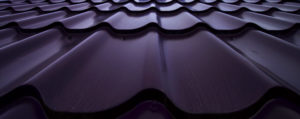
Do you have a question we didn’t cover? We’d love to hear from you! Chat with us anytime!